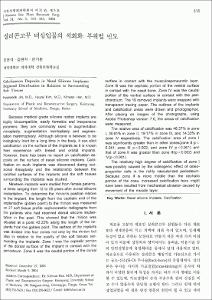KUMEL Repository
1. Journal Papers (연구논문)
1. School of Medicine (의과대학)
Dept. of Plastic Surgery (성형외과학)
실리콘고무 비삽입물의 석회화: 부위별 빈도
- Keimyung Author(s)
- Han, Ki Hwan
- Department
- Dept. of Plastic Surgery (성형외과학)
- Journal Title
- 대한성형외과학회지
- Issued Date
- 2004
- Volume
- 31
- Issue
- 3
- Abstract
- Because medical grade silicone rubber implants are highly biocompatible, easily formable and inexpensive polymers, they are commonly used in augmentation rhinoplasty, augmentation mentoplasty and augmentation mammoplasty. Although silicone is believed to be biologically inert for a long time in the body, it can elicit calcification on the surface of the implants as it is known from experience with breast and orbital implants. However, there has been no report on calcification deposits on the surface of nasal silicone implants. Calcification on such implants was discovered during revisional rhinoplasty and the relationship between the calcified surfaces of the implants and the soft tissues surrounding the implants was studied.
Nineteen implants were studied from female patients, at times ranging from 12 to 35 years after dorsal silicone implantation. To determine the rhinion's position relative to the implant, the length from the cephalic end of the implants(the 'golden point') to the rhinion was measured on 27 soft tissue profile cephalometric radiographs from the patients who had received dorsal silicone implantation in the past. This showed that the rhinion was situated at a point 42.22% along the length of the implants from the golden point. The surface of the implants was divided into four zones not only by the rhinion but also in relation to the quality of the soft tissues surrounding the implants. Zone I was the cephalic portion of the dorsal surface of the implant in contact with the periosteum. Zone II was the caudal portion of the dorsal surface in contact with the musculoaponeurotic layer. Zone III was the cephalic portion of the ventral surface in contact with the nasal bone. Zone IV was the caudal portion of the ventral surface in contact with the perichondrium. The 19 removed implants were wrapped with transparent tracing paper. The outlines of the implants and calcification areas were drawn and photographed. After placing on images of the photographs, using Adobe Photoshop version 7.0, the areas of calcification were measured.
The relative area of calcification was 48.37% in zone I, 36.61% in zone II, 19.17% in zone III, and 14.33% in zone IV respectively. The calcification area of zone I was significantly greater than in other zones(zone II p<0.041; zone III p<0.002; and zone IV p<0.001) and that of zone II was greater than zone III(p<0.002) and IV(p<0.001).
The relatively high degree of calcification of zone I was possibly caused by the osteogenic effect of osteoprogenitor cells in the richly vascularized periosteum. Because zone II is more mobile than the cephalic portion of the nose, increased calcification here might have been resulted from mechanical abrasion caused by movement of the muscle layer.
- Alternative Title
- Calcification Deposits in Nasal Silicone Implants: Regional Distribution in Relation to Surrounding Soft Tissues
- Keimyung Author(s)(Kor)
- 한기환
- Publisher
- School of Medicine
- Citation
- 김현지 et al. (2004). 실리콘고무 비삽입물의 석회화: 부위별 빈도. 대한성형외과학회지, 31(3), 315–323.
- Type
- Article
- ISSN
- 1015-6402
- Appears in Collections:
- 1. School of Medicine (의과대학) > Dept. of Plastic Surgery (성형외과학)
- 파일 목록
-
-
Download
 oak-bbb-2044.pdf
기타 데이터 / 3.03 MB / Adobe PDF
oak-bbb-2044.pdf
기타 데이터 / 3.03 MB / Adobe PDF
-
Items in Repository are protected by copyright, with all rights reserved, unless otherwise indicated.